Ever been outside and heard birds making a lot of noise? It can be confusing, right? The birds seem to be acting strange, flying around wildly, and making loud sounds. But, there’s usually a good reason for this.
Dr. Olivia Sanchez, an urban wildlife biologist at the Smithsonian, knows this well. She was watching birds near the National Mall one spring morning. She saw dozens of sparrows flying around, making high-pitched sounds. At first, she thought maybe a predator was around. But then she saw they were just trying to find mates.
Events like this show us that birds act strangely for good reasons. These behaviors are linked to the seasons, their environment, and their need to survive and reproduce. By understanding these behaviors, we can see how amazing birds are and how they live in balance with nature.
Key Takeaways:
- Birds exhibit a wide range of behaviors, from frenzied feeding to elaborate mating rituals, often in response to environmental cues and natural instincts.
- Migration, predator alerts, and nesting activities can all contribute to the perception of “crazy” bird behavior.
- Understanding the reasons behind these behaviors can help us appreciate the complex lives of our feathered neighbors and foster a more harmonious coexistence.
- Seasonal changes, food availability, and weather patterns play a significant role in shaping bird behavior.
- Observing and learning about the unique behaviors of birds can deepen our connection to the natural world around us.
Unveiling the Reasons Behind Avian Chaos
In the world of birds, their chaotic behaviors are linked to survival instincts and adapting to changes. They migrate seasonally to find food and better weather. When they find lots of food, they feed in a frenzy to prepare for the future.
Feeding is a big reason for their behavior. When birds find a lot of food, they eat a lot to save for later. This might look chaotic, but it’s a smart way to survive.
Birds also make loud calls to warn others of danger. This helps them stay safe and shows how connected they are. It’s a key way they protect themselves and work together.
Seasonal migrations add to the chaos in bird behavior. As the weather changes, they move to better places for living and finding food. This shows how well they can read the environment and keep their species going.
Learning about these behaviors helps us appreciate nature more. The chaos we see is really about their amazing ability to adapt and survive. They are truly amazing creatures.
The Spectacle of Migratory Movements
Many bird species amaze us with their long journeys to find food and better living spots. These journeys are driven by an instinct to seek out areas rich in resources and good weather. As the weather changes, birds adjust their paths and timing to survive and breed successfully.
Seasonal Journeys in Search of Sustenance
Studies show that North America’s bird populations are dropping. A study looked at 2.2 million birds of 152 species from 1960 to 2019. It found a link between birds moving far from home and geomagnetic changes during their migrations. These changes hit fall migration harder than spring, affecting both young and old birds.
Adapting to Changing Weather Patterns
The study also showed that solar activity can reduce bird wanderings. This might be because radio signals mess with their magnetic sense. Day-migrating birds feel the effects of solar activity more. These insights help us understand how other migrators, like whales, navigate.
A web tool was made to track geomagnetic conditions and predict bird wanderings. Since 1822, about 25 pfeilstorchs have been recorded, showing how far some birds travel.
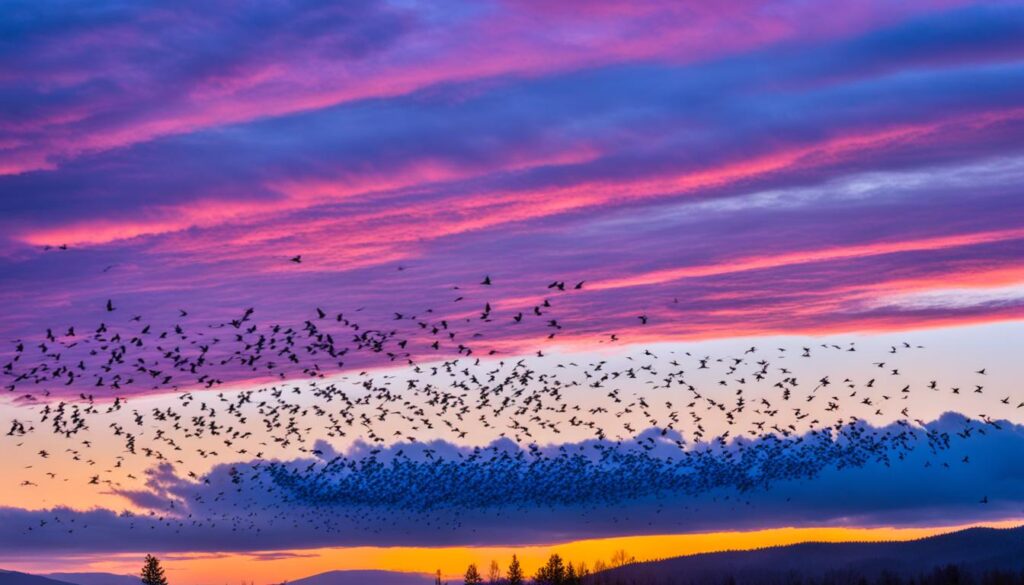
“Migration in birds serves to take advantage of seasonal environmental differences, improving survival and reproductive success.”
Obligate migration is when birds make the same journey every year, like Swainson’s Hawks and Garden Warblers. Facultative migration is when birds move based on the environment, seen in Pine Siskins. About 80% of bird species stay in one place, mostly in the tropics.
These different ways birds move and adapt to the weather show how amazing our feathered friends are at surviving in changing environments.
Feeding Frenzies: A Buffet of Abundance
Birds often come together in large groups to eat when there’s a lot of food around. This bird feeding behavior helps them fill up quickly. It’s a natural way for them to get the energy they need.
When food is easy to find in certain spots, birds will flock there. This leads to avian feeding frenzies. Seabirds, seals, and sea lions are known to do this. They gather in shallow waters to eat a lot of bird food sources.
“The intense stress emitted by distressed prey or bloody scenes is believed to trigger the frenzied state in sharks, attracting more sharks to the scene.”
Sharks also have feeding frenzies, where they follow a certain order. Whitetip reef sharks might even bite each other while fighting for food.
Feeding frenzies aren’t just in the ocean. Birds like Great Blue Herons and Great Egrets dive deep to eat. They use hunting methods of other birds to get to the bird food sources.
These amazing behaviors show how birds take advantage of food. By studying bird feeding behavior and avian feeding frenzies, we learn more about nature’s balance.
Predator Alert: The Call for Collective Safety
In the world of birds, survival depends on spotting and reacting to threats. They have developed smart bird defense mechanisms to protect themselves and others. The avian alarm call is a key way they warn each other about bird predator awareness.
When birds feel threatened, they make loud calls to alert others in their group. These calls tell other birds about the predator and the danger level. This leads to a group defense, keeping everyone safe.
- Birds may fly together in tight groups, making it tough for predators to pick one out.
- Some species will dive or “mob” the intruder, working together to scare it off.
- Against small ground predators, birds might freeze or hide, using their looks and stillness to stay hidden.
These defensive maneuvers show how birds adapt and communicate within their groups. By working together, they boost their chances of surviving dangers in the wild.
“The cognition of squirrels is highlighted in their ability to interpret signals from other species for safety.”
The system of avian alarm calls and group defense helps not just the birds but also other animals that listen in. For instance, squirrels can understand birds’ calls and change their actions, showing how connected ecosystems are.

Exploring the avian world reveals amazing adaptations for survival. Learning about bird defense mechanisms and bird predator awareness is not just interesting. It also highlights the need to protect our natural world.
Why are the Birds Going Crazy?
Birds act strangely due to natural instincts and environmental changes. Their actions, like migrations, feeding frenzies, and mating rituals, are part of nature’s cycles.
Weather changes and food availability drive their behavior. As seasons change, many birds migrate for food. This leads to the amazing sight of migratory movements. They often gather in large groups to eat, causing feeding frenzies.
Birds also work together to defend themselves and their young from predators. Watching smaller birds chase away larger birds can show how they adapt to survive.
- Red-winged Blackbirds are known to engage in mobbing behavior with other species like Great Blue Heron, Red-tailed Hawk, Osprey, and Bald Eagle.
- Common birds that participate in mobbing include chickadees, titmice, kingbirds, blackbirds, grackles, jays, and crows.
- Mobbing is particularly prevalent in spring when birds experience hormonal surges, territorial behavior, and nesting activities.
Birds also have mating rituals and nest-building activities. These actions are key to their survival and can seem chaotic to us.
“The more one studies birds, the more one marvels at the intricacies of their lives and the complexity of the interactions between them and their environment.”
Learning about these behaviors helps us see how adaptable and resilient birds are. They face many environmental changes in their lives.
The Courtship Dance: Mating Rituals Unveiled
When the breeding season comes, the bird world shines with bird mating behavior and avian courtship rituals. Birds show off with dances and bright colors to find a mate and keep their species going.
Elaborate Displays to Attract a Mate
Male birds work hard to impress potential mates. The pufferfish builds “mystery circles” on the ocean floor, spending up to 9 days on it. The spatuletail hummingbird shows off its long tail feathers, and the blue-capped cordon bleu finch dances for over a minute.
Not just males, but females also tap dance to attract mates. Males often dance faster and harder, but dance steps don’t always mean more success in finding a mate. Choosing a mate is complex and involves more than just how well they dance.
“The courtship dance displays of the cordon bleu finches are considered a unique avian example of a ‘multimodal dance display’ involving singing, bobbing, and tap dancing performed by males and females.”
Each bird species has its own way of showing off to find a mate. This shows how creative and adaptable our bird friends are in their mating rituals.
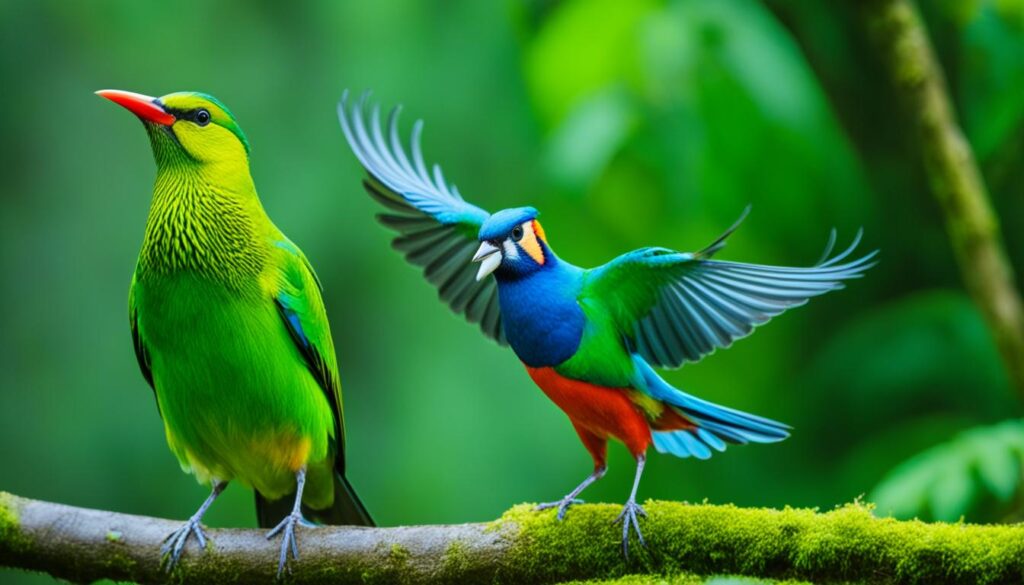
Nesting Season: Creating Cozy Havens
As the breeding season comes, birds start building nests. This is a key part of their life cycle. They make sure their nests are safe and warm for their babies. Birds collect twigs, leaves, and feathers to build these nests.
Gathering Materials and Building Nurseries
Birds show great skill in building nests. Birds preparing for breeding pick the right materials for their nests. They look for things like durability and camouflage. Each bird has its own way to make the perfect nest.
The process of building nests is detailed. Birds work hard to shape and mold their nests. They use different materials to make sure their nests are strong and safe. This shows how smart and skilled these birds are.
“The nest is the foundation of a bird’s life, a sanctuary where the next generation takes shape. It is a testament to the ingenuity and perseverance of our feathered friends.”
During nesting season, birds are very busy. They work hard to make their nests and protect their babies. This shows how connected they are to nature and how dedicated they are to their species.
Environmental Factors Influencing Bird Behavior
Birds are fascinating creatures deeply connected to their environment. Changes in weather, habitat, and food availability greatly affect their behavior. Knowing these factors is key to studying and saving bird populations.
Changes in weather patterns and bird activity are closely linked. Migratory birds plan their journeys with the weather and food in mind. Changes in temperature and wind can affect their movements and habits.
Also, habitat changes and avian behavior are closely connected. Human activities like building cities and cutting down forests change birds’ homes. This can lead to fewer nesting sites and new predators, changing how birds live.
“Understanding the complex relationship between the environment and bird behavior is essential for preserving our feathered friends and the delicate balance of the natural world.”
Studying these factors helps us understand bird challenges and how to help them. This knowledge lets us value the avian world and our role in protecting it.
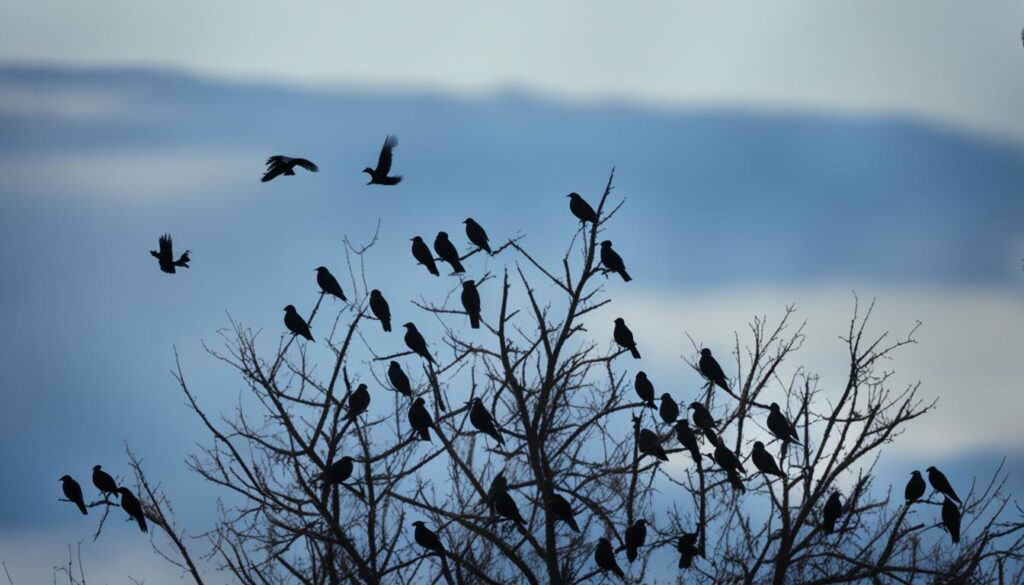
- Declining populations of Golden Eagles in the Western United States in the last 20 years.
- Increase in breeding territories of Golden Eagles from 33 to 45 in south-central Montana.
- Over 1.3 million square kilometers of native grasslands lost in the United States in the past 150 years.
Living with birds means understanding weather patterns and bird activity, habitat changes and avian behavior, and the environmental impact on bird behavior. By respecting these connections, we can help birds and humans live together well.
Interpreting the Language of Our Feathered Friends
The world of bird sounds is fascinating. It’s filled with chirps, calls, and melodies that show us how birds talk to each other. These sounds help birds defend their territory, find a mate, and communicate. By understanding these sounds, we can learn more about the world of birds.
Decoding the Chirps, Calls, and Melodies
Every bird has its own way of making sounds. Chirps are often used to stay in touch with others. Avian communication through calls can warn others of danger, mark territory, or signal where food is found. Songs in the morning are often for attracting a mate during courtship rituals.
Listening closely to bird vocalizations helps us understand their behaviors and needs. It shows us how complex the natural world is. This connection with birds can make us appreciate nature more.
“The language of the bird world is a symphony of sounds, each one a window into the lives and emotions of our feathered companions.”
Exploring understand bird language shows us how diverse and rich bird communication is. From warning calls to lullabies, each sound tells us something about birds. It shows how complex their world is.
Studying avian communication helps us learn more and respect birds more. As we learn about the bird world, we connect more with nature. This understanding brings us closer to the amazing creatures that live in the sky.
Lessons from the Avian World
Watching birds can teach us a lot about nature and our place in it. By studying their seasonal moves, eating habits, and social lives, we learn about the balance in nature. This helps us appreciate the world around us more.
Appreciating Nature’s Intricate Rhythms
Birds show us the flow of life in nature. Lessons from bird behavior make us see how everything is connected. Their migrations and dances show the beauty of nature’s design.
Learning from birds helps us see the world’s complexity. Watching how they build nests or sound alarms teaches us to notice nature’s details. These insights make us more aware of our world.
“The more we learn about the behavior of birds, the more we realize how much we can learn about ourselves and the world we live in.”
Exploring bird behavior teaches us about our role in nature. This knowledge makes us want to protect the environment. It helps us keep the homes of birds and other creatures safe.
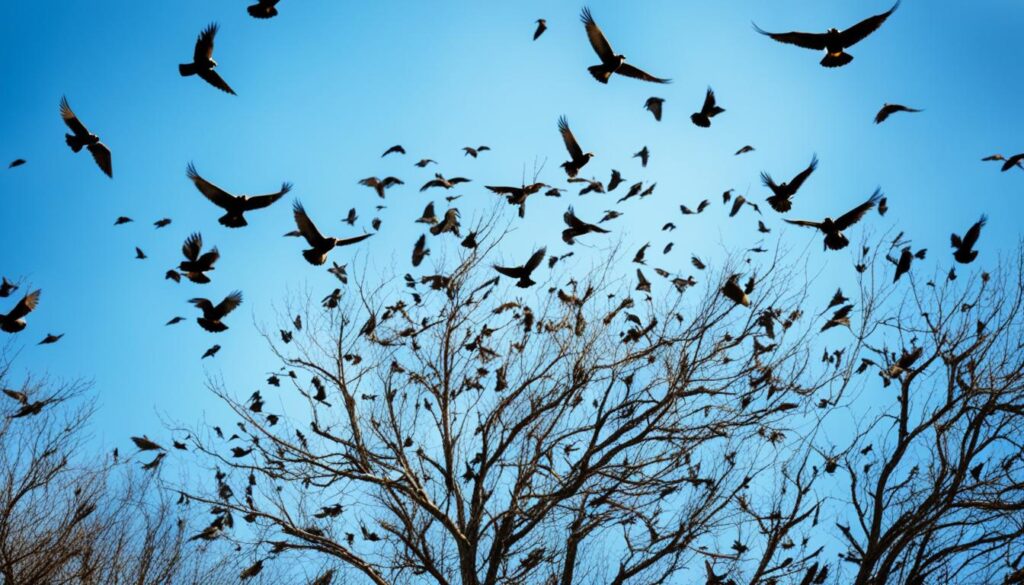
- Small brown birds that live near the ground provide the most information about other animals traveling on the ground.
- Perching birds, known as passerines like sparrows, wrens, or blackbirds, have the most reliable voices for bird language.
- Birds in the corvid family, such as jays or crows, might lead observers astray with their seemingly random squawking behavior.
- Different types of animal activities can trigger different alarm sequences in birds, indicating varied predators or threats.
- Certain bird behaviors, like wiping the bill on a branch, can also signal agitation or alarm among birds.
- Birds exhibit different responses to human presence based on factors like habitat familiarity and the observer’s demeanor.
Embracing the complexity of bird behavior helps us connect with nature. It teaches us to live in harmony with the world. The lessons from birds inspire us to live with respect for nature’s rhythms.
Embracing the Chaos: Celebrating Natural Wonders
Watching birds act in what seems like chaos, we should see their amazing survival skills. These skills have developed over thousands of years. Instead of fearing their actions, let’s see them as proof of nature’s complexity and beauty.
Learning why birds move so fast helps us value their behavior more. It also deepens our bond with nature. From their spectacular migrations to coordinated feeding, each part of their life shows their strength and flexibility.
“The bird’s beauty is not in its song, but in its amazing flight.”
Seeing the “chaos” in birds teaches us to protect our shared environments better. By appreciating bird behavior and celebrating nature, we learn about the avian chaos around us. This chaos is actually a balance of nature’s detailed cycles.
Understanding the intricate lives of birds helps us respect nature and our role in it. Embracing chaos means valuing the beauty, strength, and natural rhythms of birds. It’s not about giving up to the unpredictable. It’s about seeing the beauty and resilience in bird life.
Preservation and Conservation Efforts
The world of birds is facing big challenges. That’s why saving birds is so important. We need to protect their homes and the places they live to keep them safe for the future.
Safeguarding Avian Habitats and Ecosystems
Keeping birds safe means saving their homes. Habitat loss and fragmentation are big threats to many birds. They can’t adapt to new environments fast enough. Conservation groups are working hard to protect important bird areas.
- The collaborative conservation effort led to the largest collaborative conservation effort in history according to the Bureau of Land Management.
- Artificial water developments in sage grouse habitat lead to increased raven populations, impacting sage grouse nest survival.
- The destruction of sage grouse habitat has continued under the Biden administration, despite the collaborative conservation plan.
We also need to stop threats like bird strikes on buildings and vehicles. Plus, birds eating plastic garbage. Collaborations with experts help us tackle these problems. This way, we can save more birds.
“In 1916, the United States and Canada signed the Migratory Bird Treaty, leading to the establishment of the Migratory Bird Treaty Act of 1918, one of the country’s first major environmental legislation pieces.”
The Migratory Bird Treaty Act has been key in protecting avian habitats. It helped bring back species that were almost gone. We must keep working to save birds from new dangers.
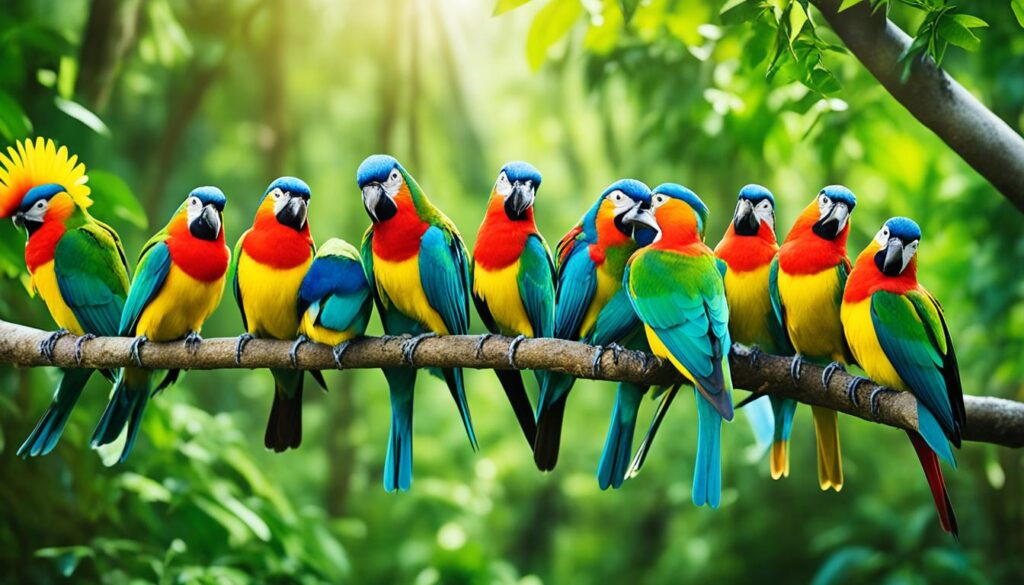
Conclusion
Birds’ “crazy” actions show us their natural instincts and how they adapt to their changing world. Their behaviors, like migration and feeding frenzies, are linked to seasonal changes and the need to survive and reproduce. This shows how complex their lives are.
Understanding why birds act the way they do helps us appreciate nature more. Behaviors like courtship dances and nest-building show their amazing adaptations. These actions let us see how birds have evolved to live in their environments.
Studying birds teaches us about the need to protect their homes and keep their populations healthy. By valuing the chaos and beauty of nature, we connect more with birds. This helps us protect these incredible creatures and their habitats for the future.
FAQ
What are the main reasons behind the seemingly “crazy” behavior of birds?
Birds act strangely for many reasons, like migrating, feeding frenzies, warning others of predators, mating, and building nests. These actions are often caused by changes in weather, food availability, and their natural instincts. These instincts help them survive and reproduce.
How do seasonal migrations impact bird behavior?
Birds migrate to find better food and living conditions. These journeys are driven by their need to survive and reproduce. As weather changes, birds adjust their migration paths and times to stay alive and breed successfully.
What causes birds to exhibit feeding frenzies?
Feeding frenzies happen when birds quickly gather to eat a lot of food in one spot. This is because they need to fill up fast to survive. These frenzies are often caused by food being concentrated in certain areas, leading to a lot of bird activity.
How do birds respond to potential threats?
Birds have ways to warn each other of dangers, like loud calls to alert the flock. When they feel threatened, they may fly together, dive, or mob the threat to protect themselves and their group.
What role do mating rituals and nesting behaviors play in the “crazy” behavior of birds?
During breeding season, birds perform mating rituals to attract a mate. These can include dances, colorful displays, and songs. They also build nests for their young, which is key to their survival.
How do environmental factors influence bird behavior?
Weather changes, food availability, and habitat conditions affect bird behavior. These changes can make them migrate, change their eating habits, or breed differently. Understanding these effects helps us study and protect birds.
How can we interpret the “language” of birds?
Birds use sounds like chirps and calls for many things, like talking to each other, defending their territory, or finding a mate. Learning to understand these sounds helps us know more about birds and their lives.
What lessons can we learn from observing bird behavior?
Watching birds teaches us about nature and our role in it. By studying their movements, eating habits, and social life, we learn about the balance in ecosystems. This can make us more aware of our impact on nature.
Why is it important to celebrate and conserve the “chaos” of the avian world?
We should see the “crazy” behavior of birds as a sign of nature’s beauty and complexity. By understanding their actions, we appreciate their survival skills. Protecting their homes is key to keeping the natural world amazing.
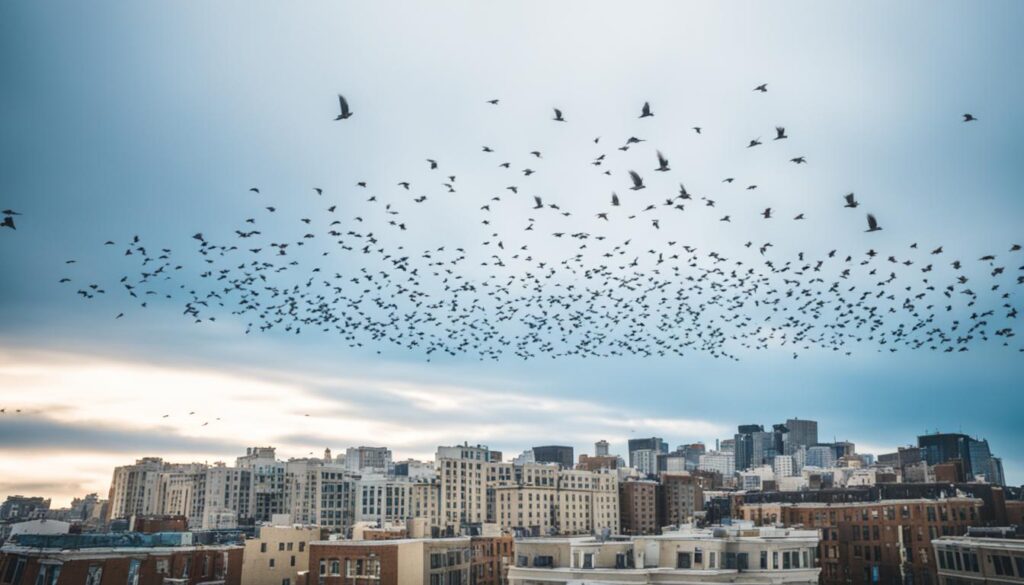

I have read so many articles about the blogger lovers however this paragraph is truly a good article,
keep it up.
Here is my web site: nordvpn coupons inspiresensation
350fairfax nordvpn special coupon code 2025
I am regular visitor, how are you everybody? This post posted at this site is
really nice.